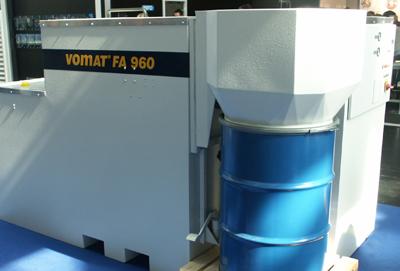
In tool grinding, the cost of cooling lubricants is generally higher than the cost of grinding wheels. Therefore, cooling lubricants offer considerable potential to reduce production costs. To capitalize on this potential, the manufacturer needs not only quality grinding oils but also capable fine filtration equipment from Vomat, which is distributed by oelheld U.S. Inc.
The filtration of cooling lubricants is an important factor in creating added value in tool grinding. If fluids are managed correctly, one can achieve not only high productivity and quality but also enormous potential for process rationalization. In many studies and recommendations, such as the (German Industry Association) VDI guideline 3397, sheet 2, successful fluid and lubricant management is a key factor in reducing production costs.
For maximum success the following applies: The finer and cleaner the medium is filtered, the higher the production quality will be. Clean, well-filtered coolant can remain in the system for a very long time. Wear and tear of the grinding wheel is greatly reduced when there are fewer abrasive particles in circulation meaning a lot more drills and cutters can be ground with one grinding disc. Machine downtime is reduced because the wheels do not need to be changed and adjusted as often.
Vomat, with its fine filtration systems, offers highly efficient filtration solutions that conquer all technical and quality challenges. Vomat has standalone units that process 120 liters (32 Gal) to 1200 liters (320 gallons) per minute and also offer customized central filter systems. Vomat uses high efficiency pre-coat filter systems which guarantee long service intervals. Vomat systems feature 100 percent separation of dirty and clean oil. Their specially designed filter technology ensures that, during both the need-based filtering and backwash cycles, clean oil meeting NAS 7 specifications (3-5µm) is provided at the point of grinding. The cooling capacity of Vomat systems ranges from 9kW to 100kW with an accuracy of +/- 0.2 K or alternatively +/- 1.0 K at ambient temperatures of 15° C to 35° C.
According to Vomat, the energy consumption of their systems is very favorable compared to conventional systems. The footprint of Vomat units is usually three-and-a-half times smaller than comparable systems while having higher filtration output than the competitors. In addition, the carbide sludge disposal volume is reduced by minimizing oil drag out. The use of Vomat equipment guarantees you will have lubricants with an astounding purity level which will significantly increase oil service life and decrease machine downtime and maintenance costs.
Contact Details
Related Glossary Terms
- abrasive
abrasive
Substance used for grinding, honing, lapping, superfinishing and polishing. Examples include garnet, emery, corundum, silicon carbide, cubic boron nitride and diamond in various grit sizes.
- coolant
coolant
Fluid that reduces temperature buildup at the tool/workpiece interface during machining. Normally takes the form of a liquid such as soluble or chemical mixtures (semisynthetic, synthetic) but can be pressurized air or other gas. Because of water’s ability to absorb great quantities of heat, it is widely used as a coolant and vehicle for various cutting compounds, with the water-to-compound ratio varying with the machining task. See cutting fluid; semisynthetic cutting fluid; soluble-oil cutting fluid; synthetic cutting fluid.
- grinding
grinding
Machining operation in which material is removed from the workpiece by a powered abrasive wheel, stone, belt, paste, sheet, compound, slurry, etc. Takes various forms: surface grinding (creates flat and/or squared surfaces); cylindrical grinding (for external cylindrical and tapered shapes, fillets, undercuts, etc.); centerless grinding; chamfering; thread and form grinding; tool and cutter grinding; offhand grinding; lapping and polishing (grinding with extremely fine grits to create ultrasmooth surfaces); honing; and disc grinding.
- grinding wheel
grinding wheel
Wheel formed from abrasive material mixed in a suitable matrix. Takes a variety of shapes but falls into two basic categories: one that cuts on its periphery, as in reciprocating grinding, and one that cuts on its side or face, as in tool and cutter grinding.

